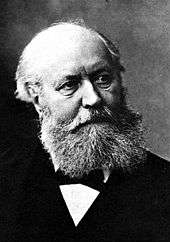Ave Maria (Bach/Gounod)
Ave Maria is a popular and much-recorded setting of the Latin prayer Ave Maria, originally published in 1853 as Méditation sur le Premier Prélude de Piano de S. Bach. The piece consists of a melody by the French Romantic composer Charles Gounod that he superimposed over an only very slightly changed version of the Prelude No. 1 in C major, BWV 846, from Book I of J. S. Bach's The Well-Tempered Clavier, published in 1722.
Composition
Gounod improvised the melody, and his future father-in-law Pierre-Joseph-Guillaume Zimmermann transcribed the improvisation[1] and in 1853 made an arrangement for violin (or cello) with piano and harmonium. The same year it appeared with the words of Alphonse de Lamartine's poem Le livre de la vie ("The Book of Life").[2] In 1859, Jacques-Léopold Heugel published a version with the familiar Latin text. The version of Bach's prelude used by Gounod includes the "Schwencke measure" (m.23), a measure allegedly added by Christian Friedrich Gottlieb Schwencke in an attempt to correct what he or someone else erroneously deemed a "faulty" progression, even though this sort of progression was standard in Bach's music.[3]
Alongside Schubert's Ave Maria, the Bach/Gounod Ave Maria has become a fixture at funerals, wedding Masses, and quinceañeras. There are many different instrumental arrangements including for violin and guitar, string quartet, piano solo, cello, and even trombones. Opera singers, such as Nellie Melba, Franco Corelli and Luciano Pavarotti, as well as choirs have recorded it hundreds of times during the twentieth century.
Later in his career, Gounod composed an unrelated setting of Ave Maria for a four-part SATB choir.
Interpretations
Alessandro Moreschi, one of the last castrato singers, performed Ave Maria and several other pieces of music on recordings for the Gramophone & Typewriter Company in the early 1900s.
A rendition by Yo-Yo Ma and Bobby McFerrin was used as the main theme in the 2017 Palme d'Or winning Swedish film The Square.
See also
- "Ellens dritter Gesang" by Franz Schubert, also known as "Ave Maria".
- "Ave Maria" by Russian composer Vladimir Vavilov, often misattributed to Italian composer Giulio Caccini.
References
- "La musique religieuse de CHARLES GOUNOD". Musica et memoria (in French). Retrieved 5 October 2014.
- "Score: Gounod Bach". Gallica. Retrieved 5 October 2014.
- Barber, Elinore (1970). "Questions to the editor". Bach. 1 (1): 19–22. JSTOR 41639775.
External links
- Ave Maria: Scores at the International Music Score Library Project (IMSLP)
- Free sheet music for voice and piano on Cantorion.org
- Free scores of the Ave Maria in the Choral Public Domain Library (ChoralWiki)
- Free scores of the SATB setting of the Ave Maria in the Choral Public Domain Library (ChoralWiki)
- Ave Maria by Gracia Gonzalez
